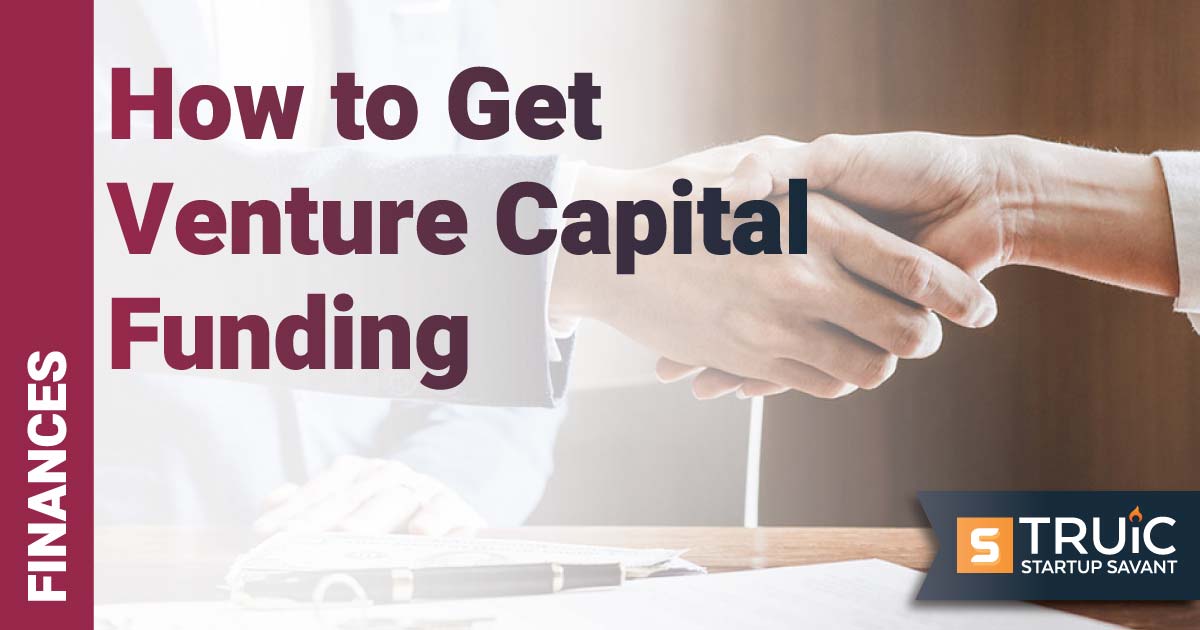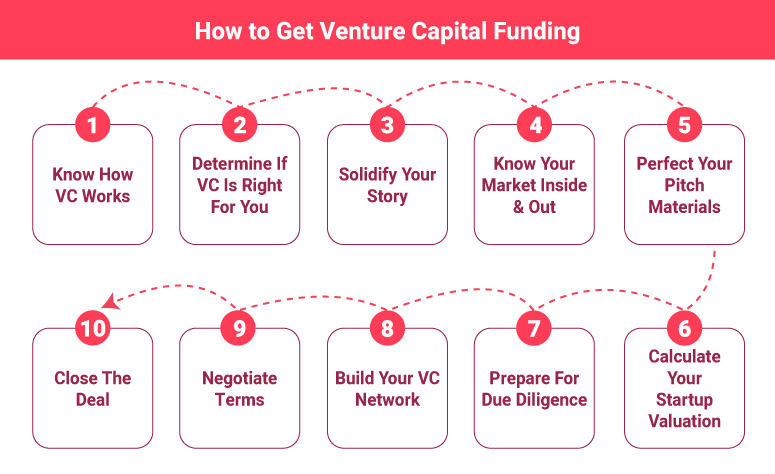How to Get Venture Capital Funding for a Startup

Last Updated: By TRUiC Team
New businesses and startup ventures are at the heart of innovation, invention, and growth. When an entrepreneur has an idea for a new business venture but doesn’t quite have the funds and startup capital to begin growing their business, the financing provided by venture capital firms often comes in to save the day.
Venture capital funding can be acquired from specialized VC firms, investment banks, financial institutions, and even well-off investors who’d like to invest in your vision.
In this guide, we’ll discuss how startups can start walking down the path of venture capital funding and explain some of the best ways to secure VC financing as quickly and efficiently as possible. Let’s get started.
Most VCs will only invest in C corporations. Simplify the process by utilizing a professional online incorporation service.
How to Get VC Funding in 10 Steps

Securing venture capital financing for your startup isn’t an easy process, but it is well worth it in the end, as it allows you to build up and grow your company even if you don’t personally have the funds to do so.
Let’s discuss several steps your startup can take to get on the path to securing VC funding and building confidence in your startup that venture capitalists can see.
Jump Ahead:
Seeking Startup Funding?
Get a complete picture of your company's value and potential with Systematic's AI-powered data analysis tools. Build your virtual data room and company dashboard to connect with potential investors today.
1. Know How Venture Capital Works
Venture capital funding can be a great way to fuel the growth of your startup and turn your entrepreneurial dreams into reality. But before you embark on this journey, it's important to understand how venture capital works.
Essentially, venture capital is money invested in your startup by firms or individuals known as venture capitalists. They invest in young, high-risk companies expecting high returns. They offer not only funds but also advice and connections. In return, they get a share in your company, meaning you'll share control.
Understanding the VC process and its implications will help you make an informed decision on whether it's the right path for your business.

2. Determine If Venture Capital Funding Is Right for Your Startup
Venture capital funding isn’t right for every startup and largely depends on the goals and personality of the founder. If you’d like to maintain full control over everything you do in your business, then getting VC funding may not be the best choice. Similarly, if you are already profitable and don’t need VC funds in order to grow your business, you may consider finding a mentor instead.
Companies that are generally considered ready for venture capital usually have the following characteristics:
- Unique Value Proposition (UVP)
- Strong Management Team
- Large Addressable Market
- Scalable Business Model
- Solid Sales Funnel
Venture capital, although widely pursued, may not align with every entrepreneur's objectives, making it crucial to explore alternative funding options that better cater to your business needs and goals.
3. Solidify Your Story
Startup fundraising is more than a mere transaction — it is an art that requires finesse and a strategic approach.
Successfully securing funding involves understanding the intricacies of the investor landscape, crafting a compelling narrative, and effectively communicating the startup's vision and potential.
Founders need to craft a cohesive and compelling story about the "why" and "why now" of their venture. The story and pitch materials should seamlessly weave together the purpose, mission, and vision of the startup, illustrating the problem being solved and the unique value proposition.
This storytelling approach captures investors' attention, resonates with their investment criteria, and instills confidence in the founders' ability to seize the current market opportunity.
For a deeper dive into the art of crafting your startup story, read our comprehensive guide.
4. Know Your Market Inside Out
Understanding your market is crucial for success. This involves breaking down your Total Addressable Market (TAM), Serviceable Available Market (SAM), and Serviceable Obtainable Market (SOM). Let's unpack these terms.
- Total Addressable Market (TAM): This is the whole pie or the total market demand for your product or service. It's essential to know how big your TAM is because it shows the size of the opportunity. Remember, venture capitalists (VCs) love big markets.
- Serviceable Available Market (SAM): This is the slice of the pie you can realistically reach with your product or service. This part of the market is within your reach, and it's a subset of your TAM.
- Serviceable Obtainable Market (SOM): This is the portion of SAM that you can realistically capture in the short term. It's like the first bite of your slice.
Understanding these terms will help you determine your value proposition — the unique value you offer to customers that sets you apart from the competition.

In addition to knowing your market, here are a few more quick tips for success:
- Know Your Competition: Identify who they are and understand their strengths and weaknesses. Always be ready to explain why your solution is better.
- Stay on Top of Market Trends: Keep an eye on changes in the market, like new technologies or changes in regulations. Adaptation is key.
- Plan Your Customer Acquisition: Be clear on how you will attract and retain customers. It should be cost-effective and align with your target market.
- Show Scalability: Have a plan to grow your business quickly. VCs want to see that your business can expand rapidly.
Last but not least, keep in mind that VCs typically seek a minimum 10x return on their investment due to the high risk and uncertain nature of the startups they invest in.
It's important to note that the 10x rule is not an absolute requirement for every startup. Some businesses may have different goals or operate in niche markets where smaller returns are still considered successful. However, being aware of this rule and its implications can help founders navigate the startup landscape and communicate effectively with investors.
5. Perfect Your Pitch Materials
Your pitch materials are essential in capturing the attention and interest of venture capitalists. These materials include your business plan, pitch deck, and any supporting documents that showcase your business idea and its potential for growth.
Business Plan
A business plan is a document that outlines your vision, strategy, and financial projections for your venture. It serves as a roadmap that investors can refer to in order to understand your business, its potential, and the return on their investment.
Start your business plan with an executive summary that provides a concise overview of your company. Highlight the key aspects of your business, such as its:
- Mission
- UVP
- Target Market
- Growth Potential
Build a winning business plan for your startup with LivePlan, our #1 recommended business plan software.
Pitch Deck
A pitch deck is a concise presentation consisting of slides that conveys the key aspects of a business, product, or idea to potential investors or stakeholders. When crafting your pitch deck, be sure to include the following key elements:
- Company purpose
- Problem
- Solution
- “Why now?”
- Market analysis
- Business model
- Product or service
- Team
- Financial projections
- Ask
Remember, your pitch deck should be visually appealing, concise, and easy to understand. Use bullet points, graphics, and charts to convey information effectively. Practice your pitch to ensure a confident and engaging delivery.
Learn more about pitch decks and discover step-by-step instructions for creating a compelling one by visiting our guide on how to create a pitch deck for your startup.
6. Calculate Your Startup Valuation
Valuing your startup is an important step before seeking venture capital funding. It helps you determine the worth of your business and provides a basis for negotiating investment terms.
There's no one-size-fits-all method, but here are a few steps to guide you:
- Know the Landscape: Understand the success rate and valuation ranges in your field. This varies by geography, stage, and sector, so use data relevant to your startup.
- Value Your Present: Your startup's valuation should reflect what you've achieved. This is about one-third of your total valuation.
- Value Your Future: About two-thirds of your valuation should represent your future plans, including market size and growth strategies.
Remember, your startup's valuation isn't just a number—it's a reflection of your hard work, innovation, and potential for growth. It's your chance to show venture capitalists why your business is worth their investment.
Learn the ins and outs of startup valuation by reading our comprehensive guide on how to value a startup.
7. Prepare for Due Diligence
Due diligence is a term that describes the careful examination venture capitalists carry out before they invest in your business. It's like a detailed 'background check' for your company.
What Documents Are Required?
During due diligence, investors will want to see several important documents. These typically include:
- Business Plan: This outlines your business strategy and goals.
- Financial Statements: These include profit and loss statements, balance sheets, and cash flow statements.
- Legal Documents: Such as articles of incorporation, bylaws, and contracts.
- Intellectual Property (IP) Documentation: If your business relies on unique inventions, designs, or trademarks.
- Team and Market Information: Details about your team and the market you operate in.
Check out Y Combinator’s Series A Diligence Checklist to help you further navigate investor requirements.
The goal of due diligence is to confirm that your business is a good investment opportunity. By preparing these documents ahead of time, you can speed up the process and increase your chances of securing funding.
Be ready to answer any questions that might come up in a clear and confident way. Your preparation can go a long way in building trust with potential investors.
Additionally, hiring a lawyer to assist with the due diligence process when seeking venture capital funding is highly recommended for several reasons:
- Legal Expertise: Lawyers are trained to understand and interpret laws and regulations that your startup needs to comply with.
- Documentation Review: They can help organize and review the vast number of legal documents that need to be provided during the due diligence process, including intellectual property documents, incorporation papers, and more.
- Risk Mitigation: Lawyers can help identify any potential legal risks or liabilities that could affect the investment.
- Negotiations and Agreements: Legal professionals can guide you during the negotiation process and help draft and review term sheets, shareholder agreements, and other important investment-related documents.
- Saving Time: Lawyers can significantly speed up the due diligence process by knowing what information is needed and how it should be presented.
8. Build Your VC Network
Many VC deals happen within a network of known contacts. So, while it's critical to have a compelling business model, robust technology, or a unique value proposition, being well-connected within the industry can be a significant advantage. Here are a few tips to begin building your venture capital network:
Leverage Your Existing Contacts
Reach out to your network of contacts, including friends, family, former colleagues, mentors, and industry peers; ask if they know any venture capitalists or angel investors who might be interested in your venture.
An introduction from someone the investor knows and trusts serves as a warm introduction. It helps you bypass some of the initial skepticism or barriers that come with cold outreach. Warm introductions increase the chances of getting your foot in the door and having your pitch heard.
Even if your existing contacts don't have direct connections to investors, they may know someone who can serve as a mentor or advisor to you. This person could have their own network of investors, providing valuable guidance and introductions.
The power of networking lies in the "six degrees of separation" concept, which suggests that everyone is connected to each other through a chain of six or fewer acquaintances.
Do Your Research and Create a List
Research venture capital firms or individual investors and understand which ones are most likely to invest in your industry and type of startup. Some VC firms specialize in certain types of businesses and only invest in what they know. Others are more flexible and invest in a wide range of startups in their VC portfolio.
Creating a list of potential venture capitalists is a valuable step in the process. You can utilize online resources, such as directories or industry-specific websites, to find information about various VC firms and their investment criteria. Here are a few resources we recommend:
Don’t Overlook the Power of Social Media
Many venture capitalists maintain a professional presence on social media platforms like LinkedIn, where they share insights, connect with entrepreneurs, and announce investment opportunities. Engaging with their content and establishing connections can provide you with valuable networking opportunities.
Attend Meetups and Other Networking Events
You can also consider attending in-person meetups, conferences, or industry events where venture capitalists might be present. These gatherings offer a chance to interact directly with investors, showcase your startup, and build meaningful relationships.
9. Negotiate Terms
Once you've found a VC and successfully pitched your idea, you might get the opportunity to discuss a partnership. This brings us to an important step: negotiating terms.
What Is a Term Sheet?
Think of a term sheet as a map for your partnership with the VC. It's a document that outlines key points of the agreement between you and the investor. It's not a legal promise but more like a handshake on paper.
Main Sections of a Term Sheet
Here are some of the important parts you'll see in a term sheet:
- Valuation: Can include pre-money valuation (the company's estimated worth before investment or financing) and post-money valuation (the company's estimated worth after investment or financing).
- Investment amount: The amount of money that the venture capitalist (or other investors) are willing to invest in the company.
- Equity stake: Percentage of the company that the investor would own after the investment.
- Liquidation preference: In the event that the company is sold, this determines the payout order. Investors with a liquidation preference get paid before those without.
- Anti-dilution provisions: These protect the investor from future rounds of funding diluting their stake in the company.
- Voting rights: These terms outline the control the investor has over business decisions.
- Board composition: Details about who will have seats on the company's board of directors.
- Exit strategy: Plan for the investor to eventually realize their investment, often through a sale of the company or an initial public offering (IPO).
Download Y Combinator's Series A Term Sheet Template to enhance your startup's fundraising strategy.
Negotiating the Term Sheet
When it comes to mastering term sheet negotiations, keep these tips in mind:
- Understand all terms: It's your company, and you need to know what you're agreeing to.
- Don’t be afraid to ask questions: If you don’t understand something, ask for clarification.
- Seek a fair deal, not just any deal: Make sure the terms benefit both you and the VC.
In this process, having a lawyer specializing in startups or venture capital is extremely useful. They can help make sure the agreement is fair, legal, and right for your business.
10. Close the Deal
Closing a venture capital deal marks the beginning of an exciting new journey. Here are some key elements that are typically involved in closing a VC deal:
Further Due Diligence
After a term sheet is signed, more intensive due diligence may occur. This could involve a deep dive into the company's financials, technology, legal issues, market analysis, etc.
Finalizing Investment Agreement
Based on the due diligence and the term sheet, both parties negotiate and finalize the investment agreement. This document is legally binding and outlines in detail the rights and obligations of the startup and the investors.
Legal Review and Documentation
Lawyers from both sides will review the agreement, ensuring it's legally sound and that it protects the interests of all parties involved. Any necessary legal documentation such as amendments to the company's Articles of Incorporation, new Shareholders Agreements, or Subscription Agreements will be prepared.
Closing Meeting and Fund Transfer
Once the final agreement is signed, a closing meeting is usually held. This meeting signifies the end of the negotiation and due diligence process. After the closing meeting, funds are usually transferred from the venture capital firm to the startup's bank account.
Post-Closing Obligations
After the deal is closed, the startup will have obligations to its new investors, such as providing regular updates about its business operations, financial status, etc.
Post-Investment
Once the deal is closed, your relationship with the venture capitalist will shift from negotiation to collaboration. The venture capitalist will typically become an active partner, offering strategic guidance and leveraging their networks to support your business's growth. Regular communication and updates will be essential to maintain a strong partnership.
Milestone Tracking
Venture capitalists often set specific milestones or targets that your business should aim to achieve. These milestones serve as benchmarks to measure progress and help demonstrate the growth potential of your business. Regularly track and report on your progress to keep the venture capitalist informed and build trust.
Remember, this is a generalized process, and the exact steps can vary depending on the specifics of the deal, the countries involved, the VC firm's process, etc. The timeframe for this process can range from a few weeks to several months, depending on the complexity of the deal and the level of due diligence required.
Additional tips:
- A personal website is essential for founders before pitching to venture capital investors. It showcases their expertise, builds trust, and establishes a strong personal brand.
- Profiles on platforms like AngelList and Crunchbase (and Startup Savant!) are also vital for founders seeking venture capital. They provide visibility, credibility, and access to a wide network of investors.
- Investors pay attention to the dynamics within a team during the pitch process. A cohesive and respectful team sends a powerful message about the startup's culture and its potential for long-term success.
- Leveraging contacts, seeking introductions, and securing an advisor from the venture capital industry can provide founders with a competitive edge, access to valuable expertise, and increased opportunities for successful fundraising.
Final Thoughts
Obtaining venture capital funding for your startup might seem like a big mountain to climb, but it is very achievable when you follow the right steps.
Start by developing a strong business plan that tells the story of your idea. Practice your pitch and be prepared to present your idea passionately and persuasively.
Remember, securing funding is about building relationships, so don't rush the process. Engage with venture capitalists, other entrepreneurs, and industry experts to get insights, advice, and potential leads. Attend industry events, join online communities, and leverage platforms like LinkedIn to build and nurture these relationships.
Finally, be patient and persistent. Securing venture capital is a challenging process that takes time, effort, and resilience. You may face rejection, but don't let that discourage you. Learn from each experience and continue to refine your pitch and business plan.
Recommended: Don't just find venture capitalists—let them discover you. Systematic connects startups and investors on one AI-powered platform. Get started today.


